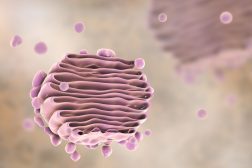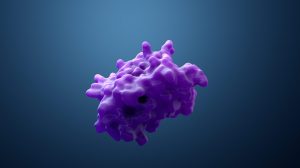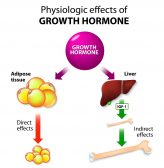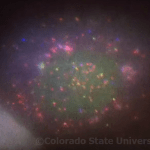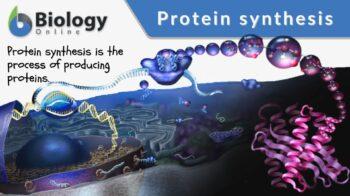
Protein synthesis
n., plural: protein syntheses
Definition: the creation of protein.
Table of Contents
Protein synthesis is the process of creating protein molecules. In biological systems, it involves amino acid synthesis, transcription, translation, and post-translational events. In amino acid synthesis, there is a set of biochemical processes that produce amino acids from carbon sources like glucose.
Not all amino acids are produced by the body; other amino acids are obtained from the diet. Within the cells, proteins are generated involving transcription and translation processes. In brief, transcription is the process by which the mRNA template is transcribed from DNA.
The template is used for the succeeding step, translation. In translation, the amino acids are linked together in a particular order based on the genetic code. After translation, the newly formed protein undergoes further processing, such as proteolysis, post-translational modification, and protein folding.
Proteins are made up of amino acids that are arrainged in orderly fashion. Discover how the cell organizes protein synthesis with the help of the RNAs. You’re more than welcome to join us in our Forum discussion: What does mRNA do in protein synthesis?
Protein Synthesis Definition
Protein synthesis is the creation of proteins. In biological systems, it is carried out inside the cell. In prokaryotes, it occurs in the cytoplasm. In eukaryotes, it initially occurs in the nucleus to create a transcript (mRNA) of the coding region of the DNA. The transcript leaves the nucleus and reaches the ribosomes for translation into a protein molecule with a specific sequence of amino acids.
Protein synthesis is the creation of proteins by cells that uses DNA, RNA, and various enzymes. It generally includes transcription, translation, and post-translational events, such as protein folding, modifications, and proteolysis.
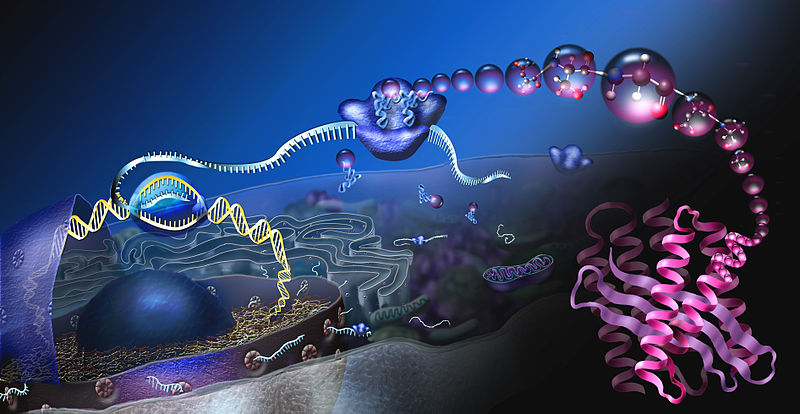
Etymology
The term protein came from Late Greek prōteios, prōtos, meaning “first”. The word synthesis came from Greek sunthesis, from suntithenai, meaning “to put together”. Variant: protein biosynthesis.
![]() Forum Question: Where does protein synthesis take place? Best Answer!
Forum Question: Where does protein synthesis take place? Best Answer!
Prokaryotic vs. Eukaryotic Protein Synthesis
Proteins are a major type of biomolecule that all living things require to thrive. Both prokaryotes and eukaryotes produce various proteins for multifarious processes and functions. Some proteins are used for structural purposes while others act as catalysts for biochemical reactions.
Prokaryotic and eukaryotic protein syntheses have distinct differences. For instance, protein synthesis in prokaryotes occurs in the cytoplasm. In eukaryotes, the first step (transcription) occurs in the nucleus. When the transcript (mRNA) is formed, it proceeds to the cytoplasm where ribosomes are located.
Here, the mRNA is translated into an amino acid chain. In the table below, differences between prokaryotic and eukaryotic protein syntheses are shown.
Protein Synthesis: Differences Between Prokaryotes and Eukaryotes | |
|---|---|
| Prokaryotic protein synthesis | Eukaryotic protein synthesis |
| Translation occurs even before the transcription of mRNA ends | Transcription occurs followed by translation |
| Except in archaebacterial, bacterial mRNA formation does not include the addition of a cap and a poly A tail | mRNA formation includes the addition of 5′ cap and a poly A tail at the 3′ end of mRNA transcript |
| Translation begins at AUG codon | Translation begins via the 5′ cap, binding the mRNA to the ribosomal unit at the first AUG codon |
| Initiating factors: PIF-1, PIF-2, PIF-3 | Initiating factors: eIF1-6, eIF4B, eIF4C, eIF4D, eIF4F |
Genetic Code
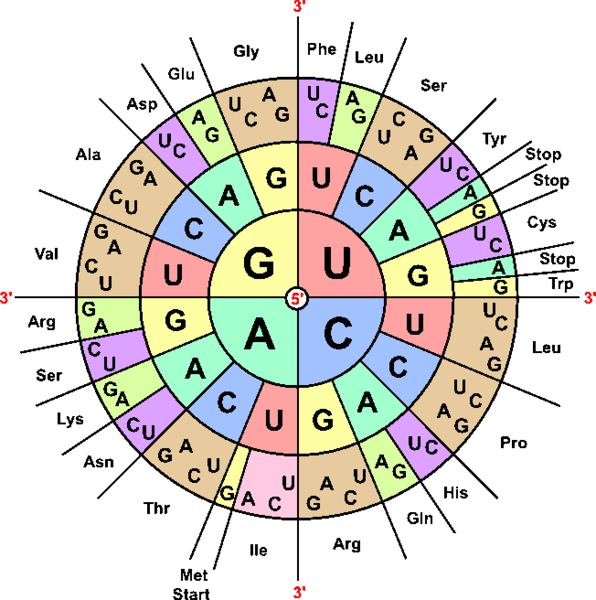
In biology, a codon refers to the trinucleotides that specify for a particular amino acid. For example, Guanine-Cytosine-Cytosine (GCC) codes for the amino acid alanine.
The Guanine-Uracil-Uracil (GUU) codes for valine. Uracil-Adenine-Adenine (UAA) is a stop codon. The codon of the mRNA complements the trinucleotide (called anticodon) in the tRNA.
What is the Genetic Code? “The genetic code is the system that combines different components of protein synthesis, like DNA, mRNA, tRNA…” More FAQ answered by our biology expert in the Forum: What does mRNA do in protein synthesis? Come join us now!
mRNA, tRNA, and rRNA
mRNA, tRNA, and rRNA are the three major types of RNA involved in protein synthesis. The mRNA (or messenger RNA) carries the code for making a protein. In eukaryotes, it is formed inside the nucleus and consists of a 5′ cap, 5’UTR region, coding region, 3’UTR region, and poly(A) tail. The copy of a DNA segment for gene expression is located in its coding region. It begins with a start codon at 5’end and a stop codon at the 3′ end.
tRNA (or transfer RNA), as the name implies, transfers the specific amino acid to the ribosome to be added to the growing chain of amino acid. It consists of two major sites: (1) anticodon arm and (2) acceptor stem. The anticodon arm contains the anticodon that complementary base pairs with the codon of the mRNA. The acceptor stem is the site where a specific amino acid is attached (in this case, the tRNA with amino acid is called aminoacyl-tRNA). A peptidyl-tRNA is the tRNA that holds the growing polypeptide chain.
Unlike the first two, rRNA (or ribosomal RNA) does not carry genetic information. Rather, it serves as one of the components of the ribosome. The ribosome is a cytoplasmic structure in cells of prokaryotes and eukaryotes that are known for serving as a site of protein synthesis. The ribosomes can be used to determine a prokaryote from a eukaryote.
Prokaryotes have 70S ribosomes whereas eukaryotes have 80S ribosomes. Both types, though, are each made up of two subunits of differing sizes. The larger subunit serves as the ribozyme that catalyzes the peptide bond formation between amino acids. rRNA has three binding sites: A, P, and E sites. The A (aminoacyl) site is where aminoacyl-tRNA docks. The P (peptidyl) site is where peptidyl-tRNA binds. The E (exit) site is where the tRNA leaves the ribosome.
Protein Biosynthesis Steps
Major steps of protein biosynthesis:
- Transcription
- Translation
- Post-translation
Transcription
Transcription is the process by which an mRNA template, encoding the sequence of the protein in the form of a trinucleotide code, is transcribed from DNA to provide a template for translation through the help of the enzyme, RNA polymerase.
Thus, transcription is regarded as the first step of gene expression. Similar to DNA replication, the transcription proceeds in the 5′ → 3′ direction. But unlike DNA replication, transcription needs no primer to initiate the process and, instead of thymine, uracil pairs with adenine.
The steps of transcription are as follows: (1) Initiation, (2) Promoter escape, (3) Elongation, and (4) Termination.
Step 1: Initiation
The first step, initiation, is when the RNA polymerase, with the assistance of certain transcription factors, binds to the promoter of DNA. This leads to the opening (unwinding) of DNA at the promoter region, forming a transcription bubble. A transcription start site in the transcription bubble binds to the RNA polymerase, particularly to the latter’s initiating NTP and an extending NTP. A phase of abortive cycles of synthesis occurs resulting in the release of short mRNA transcripts (about 2 to 15 nucleotides).
Step 2: Promoter escape
The next step is for the RNA polymerase to escape the promoter so that it can enter into the elongation step.
Step 3: Elongation
During elongation, RNA polymerase traverses the template strand of the DNA and base pairs with the nucleotides on the template (noncoding) strand. This results in an mRNA transcript containing a copy of the coding strand of DNA, except for thymines that are replaced by uracils. The sugar-phosphate backbone forms through RNA polymerase.
Step 4: Termination
The last step is termination. During this phase, the hydrogen bonds of the RNA-DNA helix break. In eukaryotes, the mRNA transcript goes through further processing. It goes through polyadenylation, capping, and splicing.
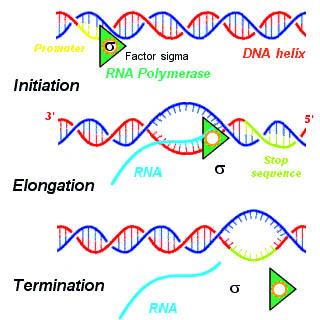
Translation
Translation is the process in which amino acids are linked together in a specific order according to the rules specified by the genetic code. It occurs in the cytoplasm where the ribosomes are located. It consists of four phases:
- Activation (the amino acid is covalently bonded to the tRNA),
- Initiation (the small subunit of the ribosome binds to 5′ end of mRNA with the help of initiation factors)
- Elongation (the next aminoacyl-tRNA in line binds to the ribosome along with GTP and an elongation factor)
- Termination (the A site of the ribosome faces a stop codon)
Post-translation Events
Following protein synthesis are events such as proteolysis and protein folding. Proteolysis refers to the cleavage of proteins by proteases. Through it, N-terminal, C-terminal, or the internal amino-acid residues are removed from the polypeptide.
Post-translational modification refers to the enzymatic processing of a polypeptide chain following translation and peptide bond formation. The ends and the side chains of the polypeptide may be modified in order to ensure proper cellular localization and function. Protein folding is the folding of the polypeptide chains to assume secondary and tertiary structures.
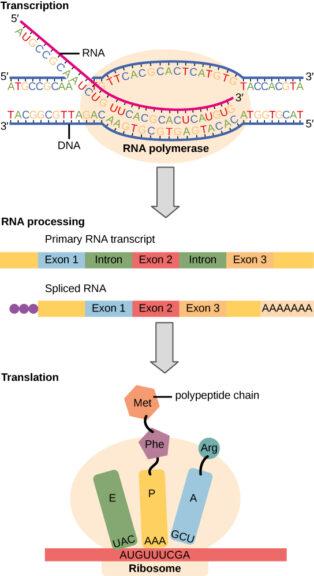
Watch this video about Protein Translation:
Has this info helped you understand the topic? Got any question? How about hearing answers directly from our community? Join us in our Forum: What does mRNA do in protein synthesis? Let’s keep it fun and simple!
Try to answer the quiz below to check what you have learned so far about protein synthesis.
Further Reading
References
- Protein Synthesis. (2019). Retrieved from Elmhurst.edu website: http://chemistry.elmhurst.edu/vchembook/584proteinsyn.html
- Protein Synthesis. (2019). Retrieved from Estrellamountain.edu website: https://www2.estrellamountain.edu/faculty/farabee/biobk/BioBookPROTSYn.html
- Protein Synthesis. (2019). Retrieved from Nau.edu website: http://www2.nau.edu/lrm22/lessons/protein-synthesis/protein-synthesis.htm
© Biology Online. Content provided and moderated by Biology Online Editors



